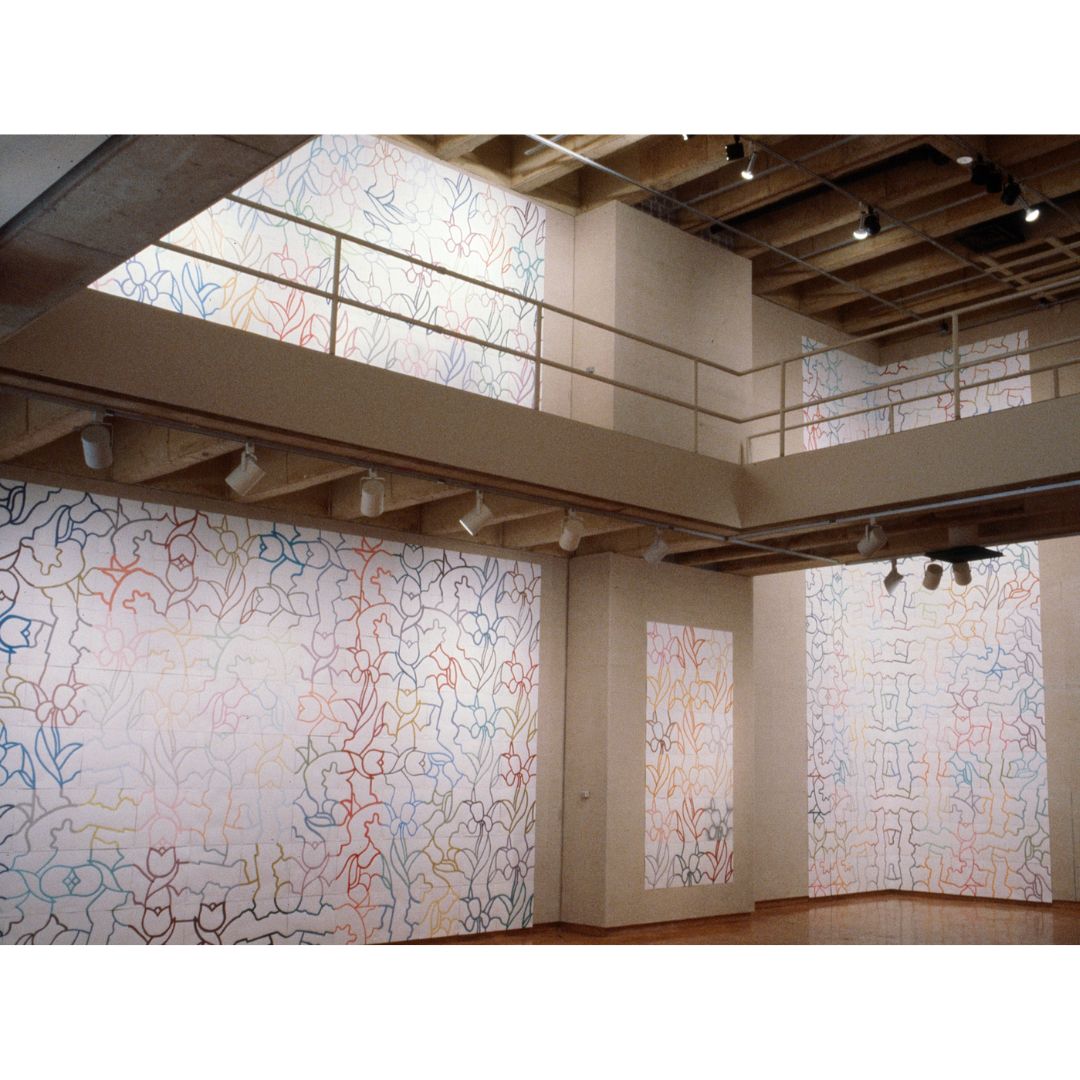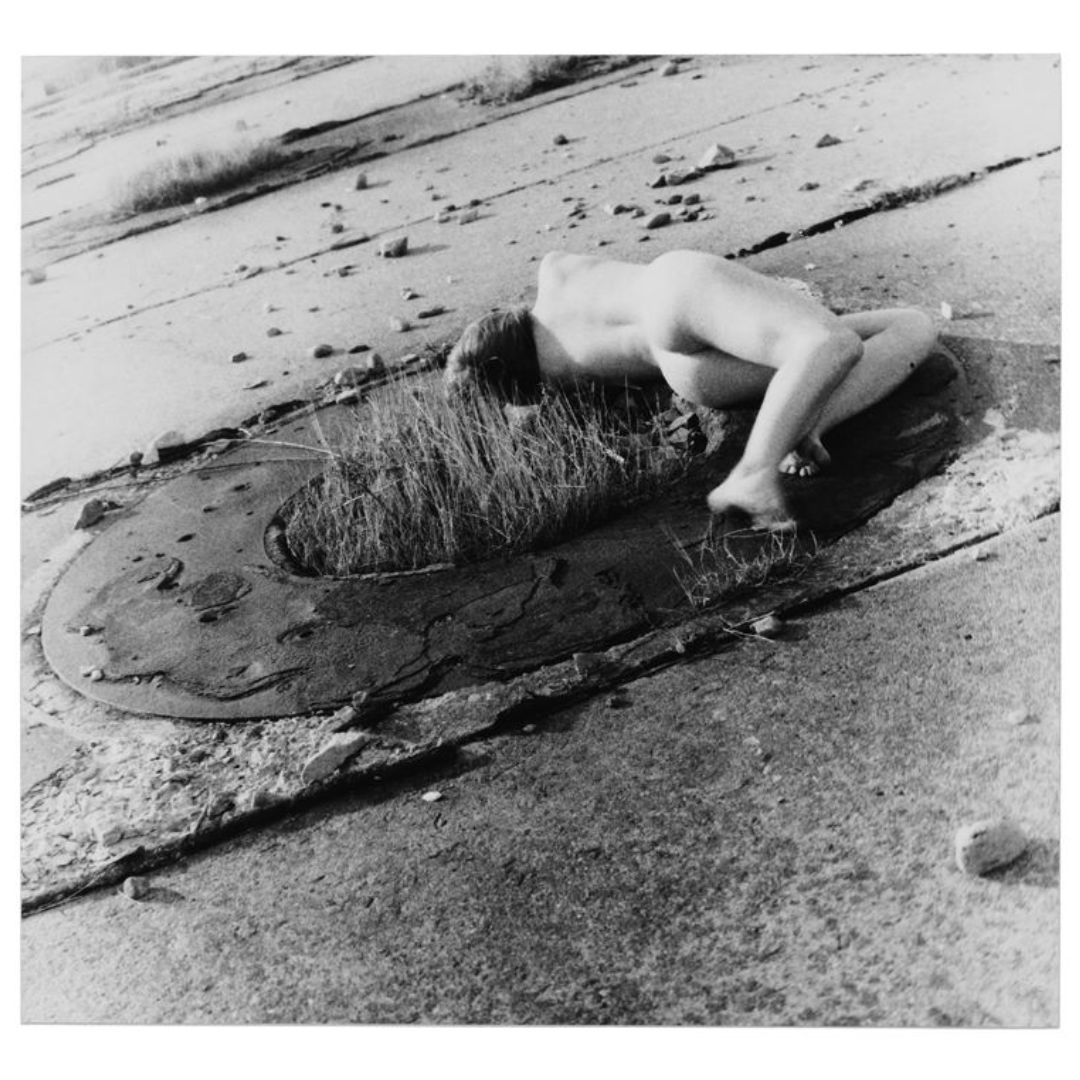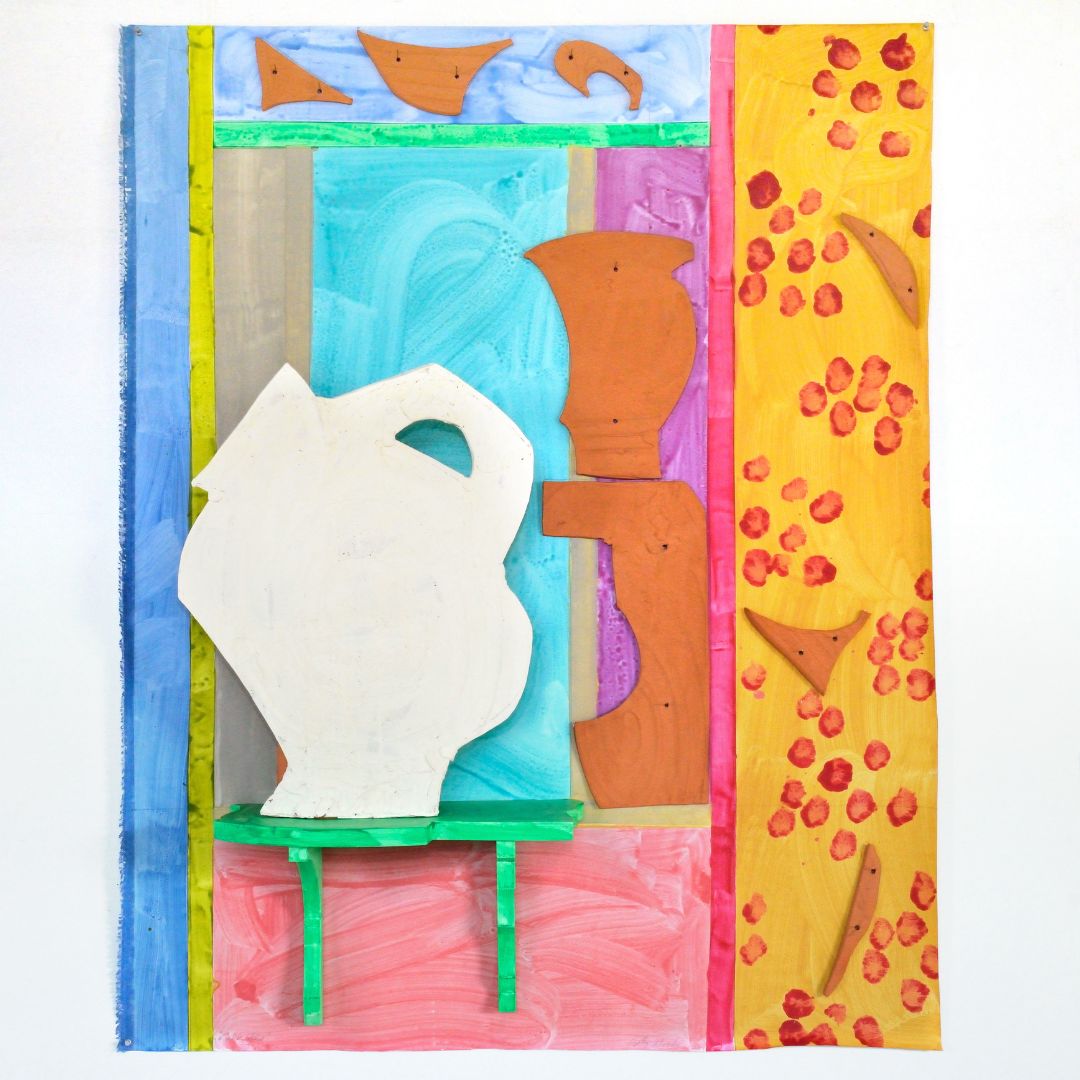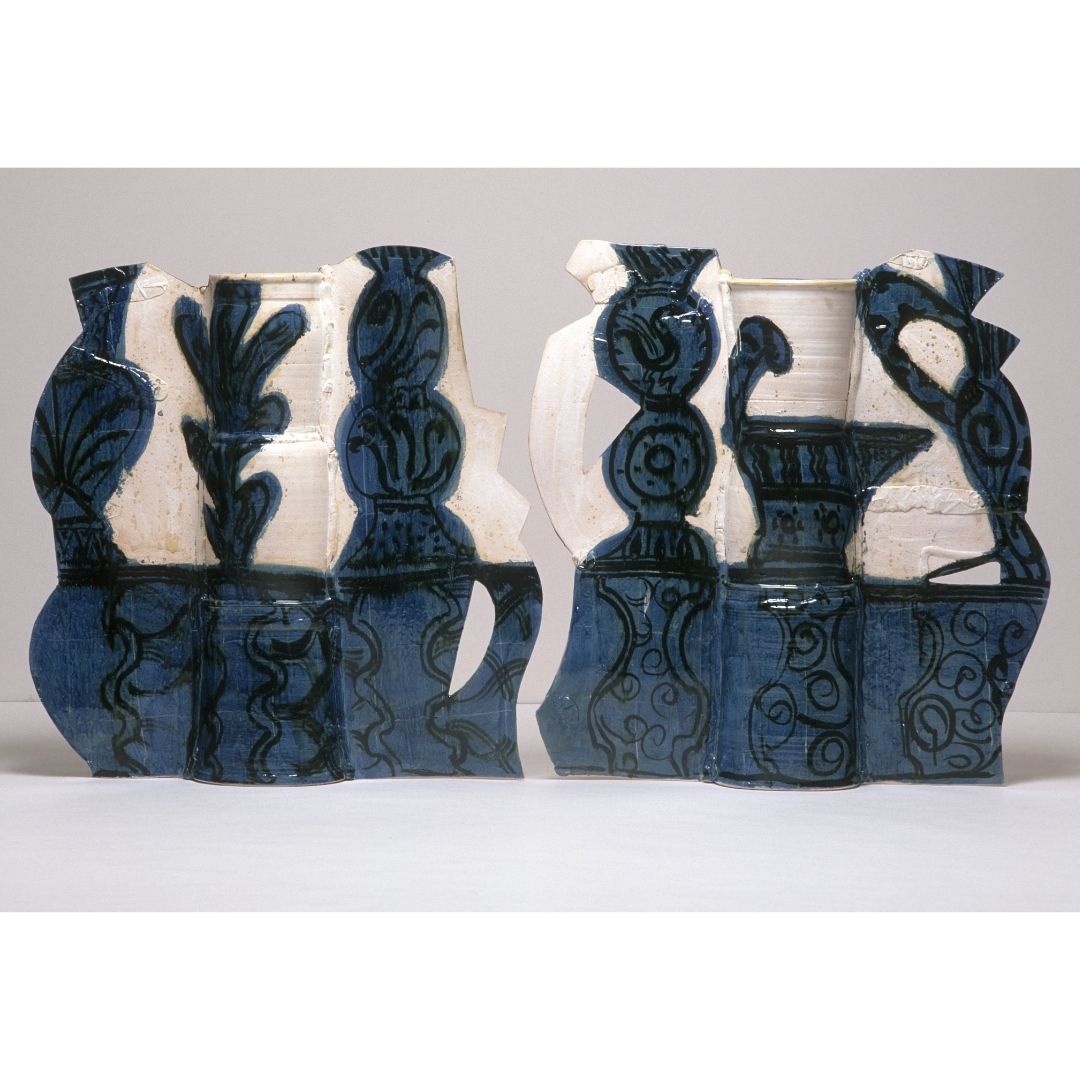L to R: 1: “Naiads and Poppies,” 2002, 20 x 12 in. Gelatin silver print | 2: Mary Delany. “Punica Granatum,” 1778. Paper collage with body color, watercolor, ink. Collection of the British Museum | 3: “Lovers within Venus,” 1990, 14 1/2 x 20 in. Gelatin silver print | 4: “The Choreography of Saskia,” 2004, 23 3/4 x 19 3/4 in. Chromogenic print | 5: Spread from “Mrs. Delany: her life and her flowers,” 1986 | 6: “Saskia Hiding in a Bouquet,” c. 2002-04, 23 3/4 x 19 3/4 in. Chromogenic print | 7: Excerpt from “A Certain Presence.” “Paper Tilings by George Woodman,” 1982 | 8: “Paper Tilings,” 1981. Installation view, Wright State University, Dayton, OH, 1981 | 9: “Untitled,” c. 1980-84, 44 x 32 in. Oil on canvas | 10: Exhibition pamphlet, “Mrs. Delany’s Flower Collages: From the British Museum,” 1986 | 11-12: George Woodman. “Gulliver in the Garden.” The Village Voice, 4 November 1986 | 13: “The Vivienne Panels III,” c. 1993, 41 1/4 x 79 3/4 in. Gelatin silver print | 14: “Mrs. Delany: her life and her flowers,” 1986. All works by George Woodman unless indicated otherwise © Woodman Family Foundation / Artists Rights Society (ARS), New York
George Woodman. “Naiads and Poppies,” 2002, 20 x 12 in. Gelatin silver print © Woodman Family Foundation / Artists Rights Society (ARS), New York
George Woodman's review of "Mrs. Delany’s Flower Collages,” the Village Voice, 1986
George Woodman’s writings offer rare insight into his artistic sensibilities and philosophy. A prolific commentator on both his own work and that of others, his 1986 review in the Village Voice of “Mrs. Delany’s Flower Collages” at the Pierpont Morgan Library (now Morgan Library and Museum) reveals much about his enduring preoccupations.
L to R: 1: “Chandelier”, 2004. Glass, gold, painted aluminum, wire and light bulbs, 24 x 71 x 31 inches, detail view | 2: “Chandelier”, 2004 | 3: Excerpt, correspondence between Betty Woodman’s studio and vendors, January 2004 | 4: Excerpt, correspondence between Betty Woodman’s studio and vendors, May 2004 | 5: Liquid gold samples, fired at 620° C for 30 min. | 6: Betty Woodman’s notes | 7: “La Coupe des Plaisirs”, 2003/2004. Glass, gold | 8: Packing list, Reusche & Co., 2007 | 9: “Charpentier”, 2007. Glazed soft-paste porcelain | 10: “Rosa Bonheur”, 2007. Glazed soft-paste porcelain | 11: “Chardin”, 2007. Porcelain | 12: Gold foil samples, Italy | 13: "Santa Maria Della Quercia Drawing”, 2005. Terra sigillata, ink and gold leaf on paper. Woodman Family Foundation Archives. All artworks by Betty Woodman © Woodman Family Foundation / ARS, New York
Betty Woodman, detail of “Chandelier”, 2004, 24x71x31 in. Glass, gold, painted aluminum, wire and light bulbs © Woodman Family Foundation / ARS, New York
Betty Woodman's pursuit of gold
Betty Woodman's creative process was deeply informed by travel and she often returned home with ideas sparked by experiences working abroad, drawing inspiration from the techniques she encountered during residencies. An example of these influences is Woodman’s pursuit of the radiant gold that appears throughout her work.
L to R: 1: Agnes Gund and Betty Woodman, Antella, Italy, c. 2000s | 2: Agnes Gund and George Woodman, Italy, c. 1990s. Woodman Family Foundation Archives.
Agnes Gund and Betty Woodman, Antella, Italy, c. 2000s. Woodman Family Foundation Archives
Celebrating the life and impact of Agnes Gund
Tireless advocate and patron saint of art and social justice. Devoted friend and supporter to so many artists, curators, and institutions, including Betty Woodman and George Woodman and many of our Board members. Equity-focused creator of Studio in a School and the Studio Institute, whose summer interns we've been fortunate to host for many years.
L to R: 1: George Woodman. “Paper Tilings,” 1981. Installation view, Wright State University, Dayton, OH, 1981 | 2, 3: Correspondence from Betty to George, 1952. Woodman Family Foundation Archives | 4: Detail from “Paper Tilings,” 1981, Wright State University | 5: Henri Matisse. “La Vierge et l’Enfant,” 1950. From “Matisse: From Color to Architecture” | 6: George Woodman. Paper tiles, 1980. Installation view, Denver Art Museum, Denver, CO, 1980 | 7: Henri Matisse. “L’Oiseau,” 1946. From “Matisse: From Color to Architecture” | 8: Spread from “Matisse: From Color to Architecture” | 9: Chapelle du Rosaire, Vence, France. Photo © David Huguenin | 10: George Woodman. “Sentimental Geometry,” 1981, 120 x 252 in. Hand-painted paper tiles. Installation view, Yellowstone Art Center, Billings, MT, 1981 | 11: Chapelle du Rosaire, Vence, France. Photo © Musée Matisse de Nice | 12: Betty Woodman. “The Chapel,” 2011, 105 x 86 x 13 in. Glazed earthenware, epoxy resin, lacquer, acrylic paint, wood, canvas | 13: Henri Matisse. “L’Arbre de Vie,” 1949. From “Matisse: From Color to Architecture” | 14: Betty Woodman. “Windows of Matisse,” 2005, 37 x 44 1/2 x 7 1/2 in. Glazed earthenware, epoxy resin, lacquer, paint | 15: Page from “Paper Tilings by George Woodman,” 1981 | 16: “Matisse: From Color to Architecture” by René Percheron and Christian Brouder, 2004. Works by Matisse © Succession H. Matisse / Artists Rights Society (ARS), New York. Works by Betty Woodman and George Woodman © Woodman Family Foundation / ARS, New York
George Woodman. “Paper Tilings,” 1981. Installation view, Wright State University, Dayton, OH, 1981 © Woodman Family Foundation / ARS, New York
Matisse’s influence on the Woodman family: La Chapelle du Rosaire
Matisse’s influence on the Woodman family is evident not only in the joie de vivre and cut-out forms of Betty Woodman’s ceramic sculptures, but also in the architectural sensibilities that inform both her and George Woodman’s work. George’s site-specific paper tile installations, in particular, invite comparison to Matisse’s Chapelle du Rosaire—not through direct lineage, but through a shared devotion to formal clarity, and the transformative potential of scale and repetition.
L to R: 1: Francesca Woodman. “Untitled,” 1976, 6 1/2 x 7 in. Gelatin silver print | 2: Betty Woodman. “Beach Girls,” 2013, 21 x 31 1/2 in. India ink, clay, pencil and acrylic paint on paper | 3: Francesca Woodman. “Untitled,” 1976, 6 3/8 x 6 3/8 in. Gelatin silver print | 4: Betty Woodman. “At the Beach,” 2007, 50 x 84 1/2 x 0 1/2 in. Glazed earthenware, canvas, terra sigillata | 5: Francesca Woodman. “Seashore Circle,” 1976, 5 3/16 x 5 3/16 in. Gelatin silver print | 6: Betty Woodman. “Balustrade Relief Vase: 97-8,” 1997, 57 x 62 x 9 in. Glazed earthenware | 7: George Woodman. “Betty at the Seashore,” 1995, 12 x 9 1/2 in. Gelatin silver print | 8: Betty Woodman. “Low Triptych: Seaside Still Life,” 2006, 24 1/2 x 74 1/2 x 9 in. Glazed earthenware, epoxy resin, lacquer, acrylic paint | 9: Francesca Woodman. “Untitled,” c. 1979-80, 6 1/2 x 9 5/8 in. Gelatin silver print | 10: Betty Woodman. “Posing with Vases at the Beach,” 2008, 33 x 81 x 6 3/4 in. Glazed earthenware, epoxy resin, lacquer, paint | 11: Betty Woodman. “Conversations on the Shore,” 1994, 84 x 142 x 53 in. Glazed earthenware, epoxy resin, lacquer, paint © Woodman Family Foundation / Artists Rights Society (ARS), New York
Francesca Woodman. “Untitled,” 1976, 6 1/2 x 7 in. Gelatin silver print © Woodman Family Foundation / Artists Rights Society (ARS), New York
The Woodmans and the alluring shores
Betty Woodman, Francesca Woodman, and George Woodman also succumbed to the lure of beaches and seashores in their work, each artist reimagining the beachscape with a distinct sensibility and overlapping visual languages.
L to R: 1: Betty Woodman. “Lake View,” 2013, 60 x 46 x 11 1/2 in. Glazed earthenware, epoxy resin, lacquer, acrylic paint, wood, canvas | 2: George Woodman. “Love Nests at Lake Lemon,” 1962, 38 x 50 in. Oil on canvas | 3: Francesca Woodman. “Untitled,” 1979, 3 13/16 x 3 13/16 in. Gelatin silver print | 4: Betty Woodman. “Lago di Como,” 1995, 26 1/2 x 43 1/2 x 10 1/2 in. Glazed earthenware | 5: George Woodman. “Untitled,” c. 2000, 19 1/8 x 10 in. Gelatin silver print | 6: Betty Woodman. “Deco Lake Shore,” 2002, 24 x 50 in. Terra sigilatta, wax, acrylic paint, graphite on paper. Collection of the Metropolitan Museum of Art, New York. | 7: Francesca Woodman. “Untitled,” c. 1972-75, 3 7/8 x 5 7/8 in. Gelatin silver print | 8: George Woodman. “Swimming at Kippy Stroud’s,” 2002, 16 x 20. Gelatin silver print | 9: Francesca Woodman. "Untitled," c.1979-80, 4 1/2 x 4 3/4 in. Gelatin silver print © Woodman Family Foundation / Artists Rights Society (ARS), New York
Betty Woodman. “Lake View,” 2013, 60 x 46 x 11 1/2 in. Glazed earthenware, epoxy resin, lacquer, acrylic paint, wood, canvas © Woodman Family Foundation / Artists Rights Society (ARS), New York
The Woodmans and the serenity of lakes
This summer, take in the fluid beauty of water as seen through the eyes of Betty Woodman, George Woodman, and Francesca Woodman.
L to R: 1: “Azulejas - Oribe Memory,” 2003, 34 x 68 x 9 in. | 2: Portuguese Tile Vases & Their Audience,” 2001, approx. 35 x 38 x 8 in. | 3: Azulejaria barroca portuguesa: Figuras de convite” by Luísa Arruda, 1993; “Waves of influence: cinco séculos do azulejo português” by Olivia Georgia, 1995; “Caminho do oriente: Guia do azulejo” by Luísa Arruda, 1998; “Azulejaria portuguesa” by José Meco, 1985 | 4: “Portuguese Vases,” 2005, 17 x 87 x 7 in. | 5: “Chinese and Vietnamese Ceramics with Highlights from The Brow Collection.” Published by Zetterquist Galleries, 2017 | 6: “The Ming Sisters,” 2003, 32 x 81 x 8 in. | 7: “Blue Girl,” 2005, 30 x 70 x 9 in. | 8: “Untitled #15 [Study for Edition by Sèvres, Blue],” 2011/2012, 2 1/2 x 8 x 4 1/2 in. | 9: “Persian Pillow Pitcher No. 6,” 1981 | 10: “Persian Ceramics and Related Materials” by Eric J. Zetterquist, 1993 | 11: “Pillow Pitcher: Delft,” 1996, 24 x 26 x 23 in. | 12: “Divided Vases: Classic Vases - Observed,” 2002, 30 x 29 x 10 1/2 in. | 13: “Baroque Diptych,” 2001, 36 x 63 x 8 in. | 14: “Kimono Vases: October,” 1990, 30 3/4 x 43 x 9 1/2 in. | 15: “Vase and Shadow: Spiral Vase with Blue Shadow,” c. 1980s, 29 x 21 x 2 in. | 16: Page from “The Studio Potter,” Vol. 35, No. 1, December 2006. Works by Betty Woodman © Woodman Family Foundation / Artists Rights Society (ARS), New York
Betty Woodman, “Azulejas - Oribe Memory,” 2003, 34 x 68 x 9 in. Glazed earthenware © Woodman Family Foundation / Artists Rights Society (ARS), New York
Betty Woodman's favorite ceramic color, blue, and her body of work
Betty Woodman is known for her exuberant body of work, which is often bathed in vivid hues of yellow, fuchsia, red, and orange. Yet in the December 2006 issue of The Studio Potter devoted solely to color, she confessed—“without a moment’s hesitation”—that blue was her favorite.
L to R: 1, 3, 5, 7, 8: Installation views, Christopher S. Bond Courthouse, Jefferson City, MO. Commissioned by the US General Services Administration. Photo © Aaron Dougherty | 2: “River View: Sunshine,” 2012, approx. 11 x 8.5 ft. Glazed earthenware, epoxy resin, lacquer, acrylic paint, canvas, wood | 4: “River View: Day Dreaming,” 2012, approx. 11 x 8.5 ft. Glazed earthenware, epoxy resin, lacquer, acrylic paint, canvas | 6: “River View: Vases at Dusk,” 2012, approx. 11 x 8.5 ft. Glazed earthenware, epoxy resin, lacquer, acrylic paint, canvas, wood | 9: Thomas Hart Benton painting “A Social History of the State of Missouri,” 1936. Commerce and Industrial Development Collection, Missouri State Archives. | 10: Betty Woodman’s site visit to the Christopher S. Bond Courthouse, Jefferson City, MO, 2012. Artworks by Betty Woodman © Woodman Family Foundation / Artists Rights Society (ARS), New York
Installation view, Christopher S. Bond Courthouse, Jefferson City, MO. Photo © Aaron Dougherty
Betty Woodman's installation at the Christopher S. Bond Courthouse, Jefferson City, Missouri, 2012
In 2012, Betty Woodman was commissioned to create an artwork for the Christopher S. Bond courthouse in Jefferson City, Missouri, through the General Services Administration’s Art in Architecture program.
L to R: 1-4: “Dreamers and Voyagers Come to Detroit,” 1987. Installation views, Renaissance Center Station, Detroit, MI, 1987 | 5: Students laying tiles on the floor, Renaissance Center station, Detroit, MI, 1987 | 6-7: Production and silkscreening of tiles, Franco Pecchioli SRL, Borgo San Lorenzo, Tuscany, Italy | 8-9: Notes and sketches on modules’ designs and colors, 1986 | 10: Bullock, Lorinda. “A creator starts over. Renaissance indeed: tile art reborn.” Detroit Free Press, 17 November 2004 | 11-13: “Path Games,” 2004. Installation views, Renaissance Center Station, Detroit, MI, 2004 | 14: Drawing of modules for “Path Games." All artworks, sketches, and notes by George Woodman © Woodman Family Foundation / Artists Rights Society (ARS), New York. Woodman Family Foundation Archive.
George Woodman. “Dreamers and Voyagers Come to Detroit,” 1987. Installation view, Renaissance Center Station, Detroit, MI, 1987. Woodman Family Foundation Archives
George Woodman's tile installations at Detroit People Mover's Renaissance Center station, Detroit, Michigan, 1987/2004
In 1987, three years after his first ceramic tile public commission for Buffalo Metro Rail, New York, George Woodman realized an installation for the Detroit People Mover’s Renaissance Center station. A firm believer in public art, he sought to create a work that does more than simply impress at first glance but rather brings life to being in the station for commuters using the system daily.
L to R: 1: “Untitled,” 1978, 49 x 49 in. Acrylic on canvas | 2: Installation view, “George Woodman: A Democracy of Parts, Paintings 1966-1978,” DC Moore Gallery, New York, New York, 2025 | 3: “Grey Portal,” 1978, 84 x 84 in. Acrylic on canvas | 4: “Untitled,” 1978, 48 x 48 in. Acrylic on canvas | 5-7: Installation views, “Three Paper Tilings,” Claremore College, Claremore, Oklahoma, 1979 | 8: Installation view, “Paper Tilings,” Denver Art Museum, Denver, Colorado, 1980 | 9: “Sentimental Geometry,” 1981, 120 x 252 in. Paper tiles. Installation view, “Criss-Cross at Yellowstone,” Yellowstone Art Center, Billings, Montana, 1981 | 10-11: “Rochester Carpet,” 1984. Hand-painted chipboard tile installation. Bevier Gallery, Rochester Institute of Technology, Rochester, New York, 1984. All artworks by George Woodman © Woodman Family Foundation / Artists Rights Society (ARS), New York. Woodman Family Foundation Archives.
George Woodman. “Untitled,” 1978, 49 x 49 in. Acrylic on canvas © Woodman Family Foundation / Artists Rights Society (ARS), New York
Aperiodic tiling. "George Woodman: A Democracy of Parts, Paintings 1966-1978," DC Moore Gallery, New York, 2025
By 1977, George Woodman’s tessellation paintings became non-periodic or aperiodic, consisting of a set of shapes which tiled the canvas but did not necessarily repeat.
L to R: 1: “Untitled,” c. 1970s, 72 x 108 in. Medium unknown | 2: Spread from “Criss-Cross Art Communications,” No. 6, published by Criss Cross Foundation, 1978 | 3: Various issues of “Criss-Cross Art Communications” | 4: “Untitled,” c. 1970s, dimensions and medium unknown | 5: “285” or “Bari” or “Winterreise,” 1975, 65 x 65 in. Acrylic on canvas | 6: “Tessellation Sky,” 1975, 54 1/2 x 54 1/2 in. Acrylic on canvas | 7: Spread from the exhibition catalogue for “19 Artists—Emergent Americans,” published by Solomon R. Guggenheim Museum, 1981 | 8-9: Installation views, “19 Artists—Emergent Americans,” Solomon R. Guggenheim Museum, New York, 1981 | 10: “Double Reflection,” 1970, 66 x 66 in. Oil on canvas. All artworks by George Woodman © Woodman Family Foundation / Artists Rights Society (ARS), New York. Woodman Family Foundation Archives.
George Woodman. “Untitled,” c. 1970s, 72 x 108 in. Medium unknown © Woodman Family Foundation / Artists Rights Society (ARS), New York
The Criss-Cross and Pattern & Decoration Movements. "George Woodman: A Democracy of Parts, Paintings 1966-1978," DC Moore Gallery, New York, 2025
By the mid-70s, George Woodman’s singular approach to pattern painting—as harmony between color and form—was well established and recognized among artists and critics alike. Woodman’s canvases were part of the larger zeitgeist around pattern in the art of this period.
L to R: 1: “A Gentle Tessellation,” 1966/1968, 43 1/4 x 43 1/4 in. Acrylic on canvas | 2: “Pattern on Trapezoid,” 1967, 58 x 42 in. Acrylic on canvas | 3: Spread from “Award Winning Artists: Southeast and Southwest,” published by the National Council on the Arts and National Endowment for the Arts, 1968 | 4: “Untitled,” 1970, 96 x 134 in. Acrylic on canvas | 5: “Untitled,” c. 1966, dimensions & medium unknown | 6: George Woodman’s studio, Boulder, Colorado, c. 1967. Woodman Family Foundation Archives | 7: “Equivocal Hexagon,” 1967, 48 x 48 in. Acrylic on canvas | 8: “Untitled,” 1969, 48 1/4 x 48 1/4 in. Acrylic on canvas. All artworks by George Woodman © Woodman Family Foundation / Artists Rights Society (ARS), New York
George Woodman. “A Gentle Tessellation,” 1966/1968, 43 1/4 x 43 1/4 in. Acrylic on canvas © Woodman Family Foundation / Artists Rights Society (ARS), New York
George Woodman's tessellations. "George Woodman: A Democracy of Parts, Paintings 1966-1978," DC Moore Gallery, New York, 2025
Tessellations are a type of pattern in which one or more geometric shapes are repeated—and often rotated and reflected—to seamlessly cover a surface. In George Woodman’s case, that surface was a canvas.


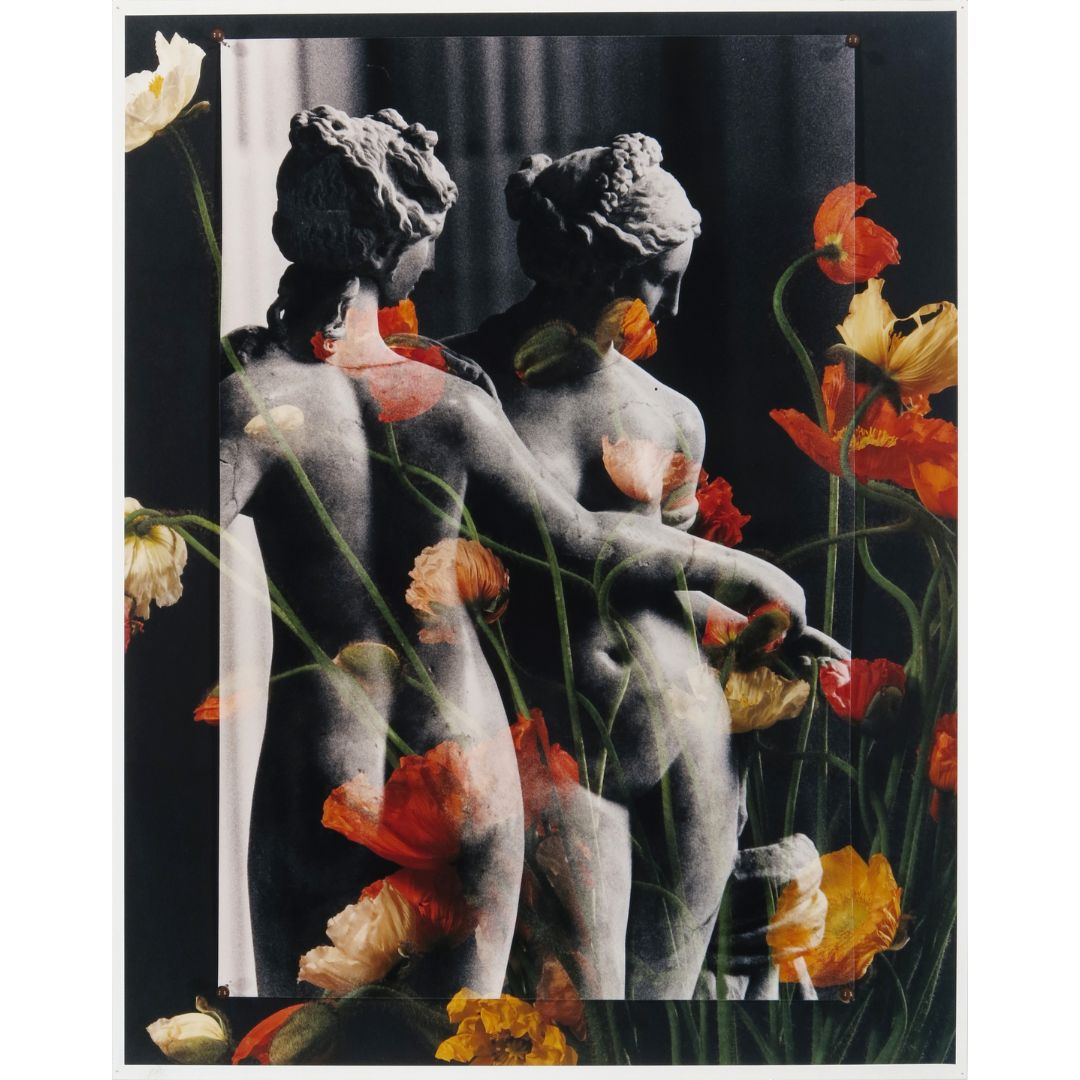
.jpg)
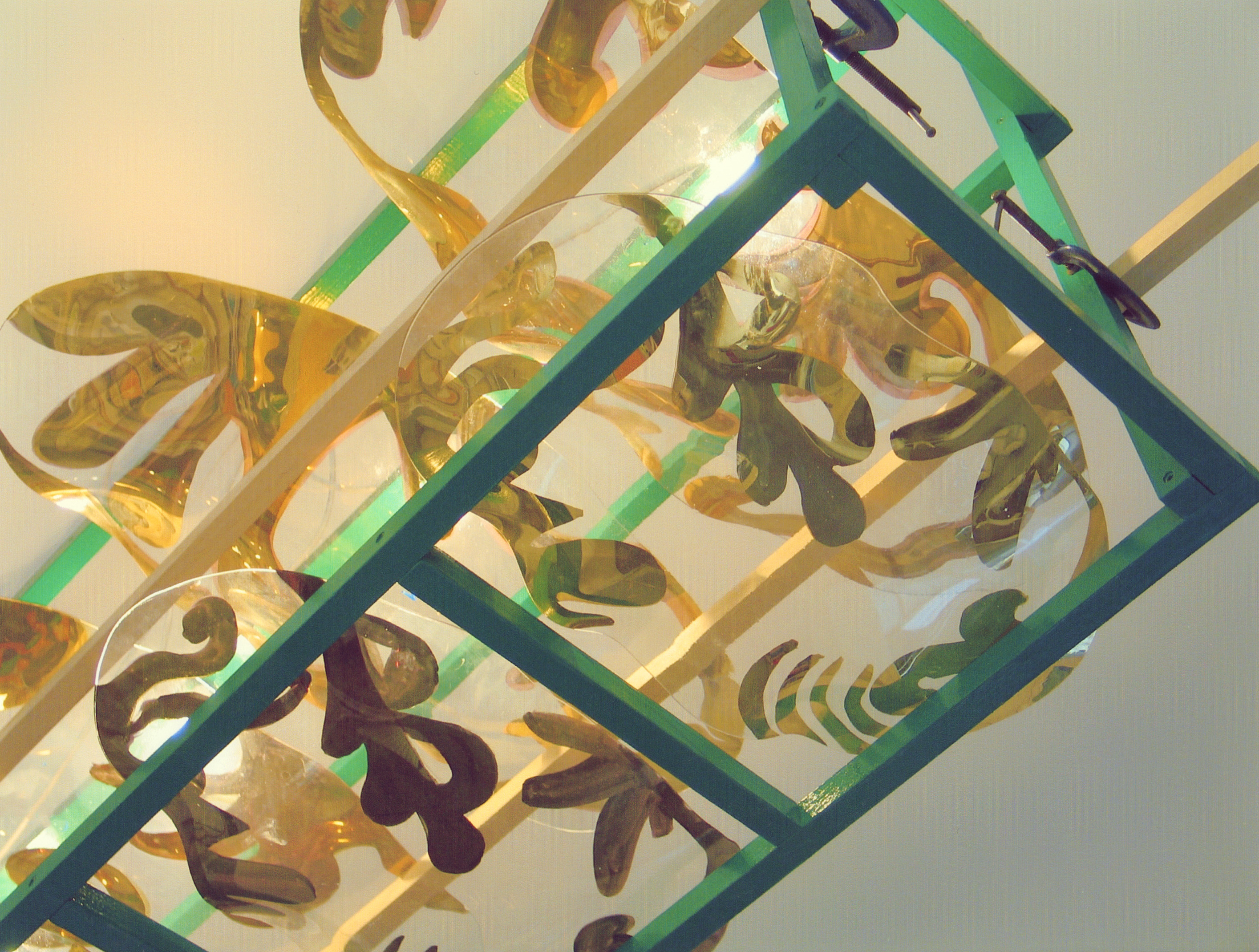

.jpg)
